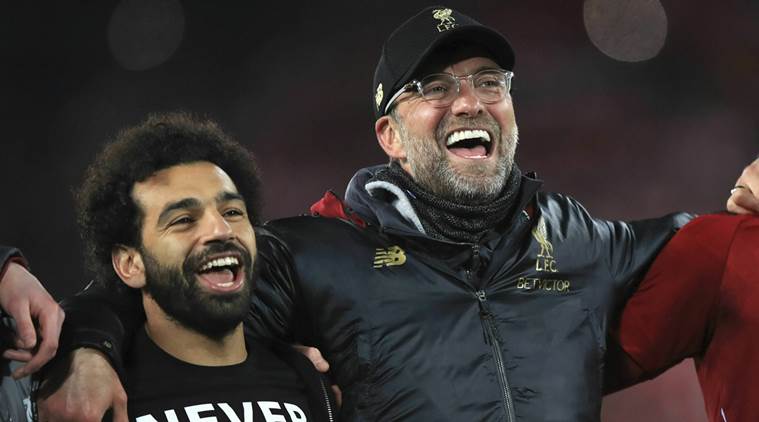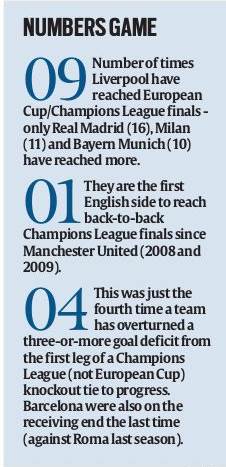
At his first press-conference as a Liverpool manager, Jurgen Klopp was asked to name the best player in the world. The big-smiling German replied, “gegenpressing,” the high-pressing brand of football that has become the German’s identity. It’s his unwavering faith in this system, with a heavy emphasis on counter-pressing that scripted ones of the greatest comeback night in sporting history.
Sustained pressing
The instinct when you lose the ball is to regroup and reorganize the defensive shape, pre-empting that the adversaries are going to launch a blistering counter. But the gegenpressing advocates believe that the best way to stop a counter-attack is to nip it straightaway, to take the counter-attackers head on and fall back. The idea is to win the ball back at the earliest. For it’s when a defending team is transitioning into an attacking one that they’re prone to losing their offensive structure.

“The opponent is still looking for orientation where to pass the ball. He will have taken his eyes off the game to make his tackle or interception and he will have expended energy. Both make him vulnerable,” Klopp had once detailed the rationale of this ploy. So essentially, the method was devised to counter the counters, though it’s open to interpretations and variations.
The Italian manager Arrigo Sacchi weaved this into a defensive framework, where the onus was to retrieve the ball in offensive channels and launch counters themselves. Pep Guardiola used this systematically to keep possession, for his butterfly football to flutter. Klopp, though, uses in its most elemental (and intimidating) way, as an outrightly attacking tool, to relentlessly attack the opponents, ratchet the pressure and make them creak. Jordi Alba would testify, as he was dispossessed, fatally, twice.
Pressing in packs
It’s not just blind, mindless pressing, rather it’s systematically scientific pressing, making quick structural alterations. Systemic flexibility is key for these methods to function efficiently—so since the opposing team was set with possession, the wide men in Liverpool 4-2-3-1 would drop back so they would defend with two traditional banks of four while the defensive midfielders venture upfront. The roles are thus quickly interchanged. It’s a reason rampaging, quick-thinking full-backs like Alexander Arnold and Andy Robertson have prospered under Klopp.
Shadow man
Often the first man to commit at attack when they lose the ball is a dummy—he knows, more often not, he can’t win the ball, but his mere presence can sow doubts, as the man to his side presses harder to dispossess the opponent. It’s generally the forwards who’re deputed the role, while hard-tackling midfielders like Johan Henderson, Fabinho and James Milner snatch the ball back and pass it on to the pacy attackers.
Pace and energy
As the emphasis is to run the fastest and furthest, to be always the first to reach the ball, their game extracts a lot of energy, a reason many critics argue that results in Klopp’s men exhausting towards the end of the season. So he found a way out of it, by selectively pressing ball-carriers and chief passers of the rivals. Against Barcelona, Klopp’s men hustled Messi and Sergio Busquests, the chief ball distributor.
How Liverpool sneaked in the fourth goal
Liverpool’s winning goal may have looked a spur-of-the-moment thing, but it goes well beyond the mere presence of mind shown by Trent Alexander-Arnold, who took the quick corner. According to The Independent, after the first leg at Camp Nou last week, Liverpool’s match analysts noticed the tendency of Barcelona players getting distracted and being slow to react whenever a set-piece was awarded against them. This intelligence was passed on to Juergen Klopp, who filtered the message through the club, which led to the formation of relevant game-plans. On Tuesday morning, Carl Lancaster — the coaching mentor at Liverpool’s academy in Kirkby — called for a meeting on Tuesday morning. One of his responsibilities is to coordinate with the ball boys. During the meeting on the day of the match, Lancaster told the ball boys to be quick when the ball goes out for a corner and throw-ins. The message wasn’t forgotten. Oakley Cannonier, a 14-year-old academy player from Leeds who was one of the ball boys, handed over the Alexander-Arnold as swiftly as he could 11 minutes from full time. Alexander-Arnold first pretended to take a normal corner but after noticing the unpreparedness of the Barca defence, he slid in a cross which Origi tapped home. Barca did not know what hit them. And Liverpool’s comeback was complete.
At least, three men always tailed Busquests, thus cutting out his passing outlets. Since Barcelona favour the left-flank, Liverpool were extra focussed on the particular channel. No wonder that all four goals originated from pressing Barcelona’s outside left channel.
Kop and the art of intimidation
Liverpool manager Klopp’s high-press tactics were magnified by the intimidating atmosphere created by fans at Anfield.
#YNWA
Before the match and long after they completed the improbable comeback, the fans belted out the club’s anthem, ‘You’ll Never Walk Alone.’ Originally written by Richard Rodgers and Oscar Hammerstein, the Merseysiders adopted the song after Liverpool-based band Gerry and the Pacemakers released a cover version in 1963. Ahead of crucial European matches, like the one on Tuesday, fans gather in the streets surrounding the stadium, light up flares and give opposition team a taste of what to expect on the pitch.
Inside the stadium, it’s a ritual for the fans to sing the anthem ahead of the kickoff to pump up the Liverpool players. The proverbial roof came off when Liverpool scored early, which unsettled Barcelona further. The close proximity between the stands and the pitch makes it a daunting task for an opponent to focus. It’s because of the crowd’s ability to galvanise the players which made Tuesday’s tie finely balanced, even though Barca had a 3-0 first-leg advantage. The most experienced visitors can become paralysed at Anfield. Barca are not the first team to surrender here. And they won’t be the last.
The intimidation tactics
While the crowd was doing its thing, the players ensured they made it clear that they would not get intimidated by Barca’s reputation. Andy Robertson handed Lionel Messi a painful welcome to Anfield with a clattering challenge early in the game. Liverpool continued to ruffle Barcelona with their physical play. While Messi was being manhandled in the middle, Luis Suarez was needled by the centre-backs as well as the crowd, who chanted ‘f*** off Suarez’ every time he touched the ball. Liverpool made Barca’s two most important players uncomfortable, and it reflected on the whole team’s performance.